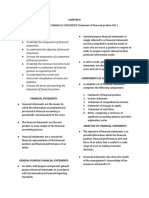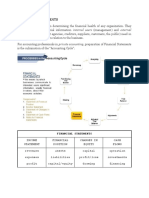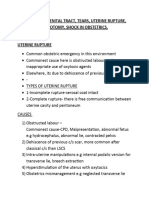CFAS
Uploaded by
Dorothy Nicole ResurreccionCFAS
Uploaded by
Dorothy Nicole ResurreccionCA5106 transactions with owners of the
enterprise.
Conceptual Framework and Notes to the Financial Statements
a. The accounting policies adopted by the
Conceptual Standards
management,
Quiz 3 b. schedules to support the balances
presented on the face of the financial
statements, and
c. other information that may be relevant
to the users but not appropriately
presented on the face of the financial
statements.
Responsibility for the Presentation of
Financial Statements (1T)
Chapter 4 - Preparing Financial Statements - Financial statements portray the economic
activities and the result of the economic
Components of Financial Statements (2T) activities undertaken by the enterprise
The objective of providing classified information to during a reporting period.
users is achieved by presenting the components of - Financial statements are generated
the financial statements. internally by an enterprise and
Statement of Financial Position communicated to those who use them as
- The financial position of the entity as of a basis for economic decisions.
a given reporting date comprising assets, - Financial statements are basically the
liabilities, and equity. representation of the company's
Statement of Comprehensive Income management
- The performance of an entity for a given - The presentation of financial statements is
reporting period. affected to a large extent by the accounting
- Two components o f comprehensive policies adopted by the management
income are presented: - Accounting policics are the
a. profit or loss and a. specific principles,
b. other comprehensive income b. bases,
Statement of Cash Flows c. conventions,
- The historical changes in cash and cash d. rules, and
equivalents during reporting period e. practices applicd by an cntity in
Statement of Changes in Equity preparing financial statements
- Events that cause changes in equity and - The accounting policies adopted by the
include profit or loss, other management should be in compliance
comprehensive income, and with the financial reporting frameworks
- Financial statements that follow the An asset is classified as a current asset if it satisfies
appropriate reporting framework arc any one of the following criteria (paragraph 66,
presumed to be fairly presented and IAS 1 Presentation of Financial Statements):
comparable with financial statements of
other enterprises within the same sector or a. It is expected to be realized in or is
industry classification. intended for sale for consumption in the
- Financial statements, except the statement entity's normal operating cycle.
of cash flows, are prepared applying the b. It is held primarily for the purpose of
accrual basis. being traded.
c. It is expected to be realized within twelve
The Statement of Financial Position (1T) months after the reporting period.
- The statement of financial position, which d. It is cash or a cash equivalent unless it is
is conventionally called the balance sheet, - restricted from being exchanged
presents the financial position of an or
enterprise as of a given date. - used to settle a liability for at least
- It presents three elements: assets, liabilities, twelve months from the end of
and equity. the reporting period.
- The statement of financial position is a Non-current Assets
formal presentation of the basic All other assets do not meet any of the foregoing
accounting equation: Assets = Liabilities + criteria are non-current assets.
Equity
- Philippine Accounting Standards - The operating cycle of an entity is the
(PAS) 1, Presentation of Financial time between the acquisition of assets for
Statements, requires the presentation of processing and their realization in cash or
assets and liabilities following the current cash equivalents
and non-current classification unless - When the entity's normal operating cycle is
presentation based on liquidity provides not clearly identifiable, it is assumed to be
more relevant information to the users. twelve months (paragraph 68, IAS 1).
- This means that, gencrally, assets and - A manufacturing entity's normal
liabilities are classified as current assets or operating cycle:
non-current. a. manufacturing entity purchases
- This manner of presentation aids the users raw materials in cash (or by
in evaluating more readily the ability of the incurring trade liabilities)
enterprise to meet its current obligations b. converts these materials through
the process of production whose
Current and Non-current Assets (3T,5P) duration depends on the nature of
Current Assets the goods being manufactured,
c. sells the manufactured goods to
customers, and
d. collects the selling price either at - Expected to be consumed within the
the time of sale or within a entity's normal operating cycle
designated credit period. Financial Assets at Fair Value through Profit
- The length of the operating cycle is the or Loss
aggregate number of days to purchase - Examples are
materials, manufacture and sell the goods, a. investments in shares of stock or
and collect the selling price. b. investments in debt instruments
- For service entities where services are of other entities that are being
completed within a relatively short traded in capital markets and
period, and collection is made after intended to be sold currently
completing the service (such as health - Held primarily for the purpose of being
provider entities, law firms, and traded
consultancy firms), the operating cycle is Non-trade receivables collectible within twelve
relatively short, probably less than a months
month - Examples are dividends receivable, interest
- Developers of condominium units and receivable and advances to officers due
other real estate companies have normal currently
operating cýcle longer than one year - Expected to be realized within twelve
because of the length of construction and months after the reporting period.
collection periods. In the latter, their
accounts receivables and uncompleted Examples of Non-current Assets
construction sites (inventories) are Property, Plant and Equipment
classified as current assets, even if they are - which include land, building, various
not realizable within one year. classes equipment, furniture and fixtures,
and tools, if used in the normal operations
Examples of Current Assets of the entity or if intended to be used in
Cash the operations of the entity in the future.
- Unless otherwise described presumed to be Intangible Assets
unrestricted - such as patents, franchises, trademarks and
Trade Receivables (Accounts and Notes customer lists, that provide economic
Receivable arising from sale of goods or rendering benefit and rights to the entity for a period
of services) of more than twelve months
- Expected to be realized within the entity's Investment Property
normal operating cycle - which includes land and/or building that
Inventories are held for appreciation in value, for
- Expected to be sold within the entity's rental to others, or for an undetermined
normal operating cycle future use.
Prepaid Expenses Financial assets that are not expected to be
realized in cash in the entity's normal operating
cycle or within twelve months after the reporting - Expected to be settled within the entity's
period, normal operating cycle
- such as: Accrued expenses
a. long-term advances to officers and - Expected to be settled within the entity's
key employees, normal operating cycle.
b. other non-trade receivables that Unearned revenues
are collectible after at least twelve - Expected to be earned within the months
months after the reporting period, from the end of the reporting period;
c. financial assets at fair value Dividends Payable
through other comprehensive - Expected to be settled within the entity's
income, after the reporting period
d. debt investments at amortized Long-term notes payable, due within twelve
cost, and months, maturity date is extended for 5 years from
e. investments in associates original maturity date through an arrangement
with the creditor completed after the reporting
Current and Non-current Liabilites (3T,5P) period
Current Liabilities - The entity does not have an unconditional
Current liabilities include obligations that meet any right as of the reporting date to postpone
of the following criteria (paragraph 69, IAS 1): settlement of the obligation for at least
a. cxpected to be settled in the entity's twelve months after the reporting period
normal operating cycle;
b. held primarily for the purpose of being Examples of Non-current Liabilities
traded; - Long-term notes payable that are due
c. due to be settled within twelve months beyond twelve months from the end of the
after the reporting pcriod; or reporting period
d. the entity does not have an unconditional - Bonds payable that are due beyond twelve
right to defer settlement of the liability for months after the reporting period;
at least twelve months after the reporting - Long-term notes payable that are due
period within twelve months after the reporting
period, but which term is extended on a
Non-Current Liabilities long-term basis and negotiation has been
All other liabilities that do not meet any of the completed before the end of the reporting
foregoing criteria are classified as non-current period
liabilities.
Equity (2T)
Examples of Current Liabilities Equity
Trade Payables (Accounts Payable and Notes - The presentation of the equity portion of
Payable which arise from purchase of goods or the statement of the financial position
services in the normal course of business)
depends on the form of the business other comprehensive income.
organization according to ownership Examples of this nature are:
- A statement of the financial position of a - revaluation surplus
sole proprietorship and presents only from the revaluation
the capital account of the proprietor. increment based on an
- Same is true with the statement of financial independent appraisal of
position of a partnership except that the property, plant and
equity balances consist of the sum of the equipment, and
capital and drawing accounts of each intangible assets;
partner (if the balances of the drawing - unrealized gains or
accounts are not permanently transferred losses on investments at
to capital), and each partner's equity is fair value through other
presented separately. comprehensive income
- The equity portion of the statement of - foreign currency
financial position of a corporate form of translation gains and
business organization is presented losses of assets and
according to the source. The shareholders' liabilities of a foreign
equity is classified into the components of operation; and
a. contributed capital, consists of - actuarial gains and losses
- share capital which may on defined benefit
be preference share and employee retirement
ordinary share plans.
- Contributed capital in
excess of the legal capital
of the corporation is
called share premiųm or
additional contributed
capital.
b. retained earnings/ accumulated
profits represents the cumulative
profits earned by the dividends
already declared
c. cumulative other
comprehensive income
represents the change in equity
arising from-owner transactions
that do not pass through the
profit or loss but are taken to
a. may affect the amounts or
classification of elements on the
face of the financial statements or
(adjusting event)
b. may require additional
information to be presented in the
notes (non adjusting event)
- Events after the reporting period are
those events, favorable and unfavorable,
Forms of the Statement of Financial Position that occur between
(1T, 5P) a. the end of the reporting period
Forms of the Statement of Financial Position and
A statement of financial position is prepared using b. the date when the financial
any of the following formats: statements are authorized for issue
Account form (paragraph 3, IAS 10, Events
- which looks like a big T - account, where After the Reporting Period)
assets are listed on the left side of the - The date of the issuance of the financial
statement, while liabilities and equity are statements is the date when the
listed on the right side management of the enterprise approves
Report form and authorizes the issue of the financial
- which is a continuous format of statements.
presenting all the three elements. Liabilities - Thus, in a corporate form of
are presented immediately after total assets organization, this is the date when the
and equity accounts are listed after the Board of Directors authorizes the financial
liabilities section. statements for issuance.
Financial position form
- which emphasizes the working capital of Classification of events after reporting period
the firm. (paragraph 3, IAS 10):
- Working capital is current assets less Adjusting events provide conditions that existed
current liabilities. at the end of the reporting period or after the
- Net assets is non-current assets minus current year-end but before the financial statements
non-current liabilities and are equal to the are issued.
equity. Non-adjusting events are those that are indicative
of conditions that arose after the reporting period.
Effects of Events after the Reporting Period It must be disclosed to the notes of financial
(1T, 2P) statements
- Events occurring after the reporting period
require assessment by the management
because these events:
receivable on the statement of financial
Adjusting Events after the Reporting Period position.
(3T) c. The determination after the reporting
- An adjusting event after the reporting period of the cost of assets purchased or the
period confirms a condition that already proceeds from assets sold during the
exists at the reporting date. reporting period. This requires the
- An entity shall adjust the amounts adjustment of the amount to be presented
recognized in its financial statements to as gain or loss on sale and the amount of
reflect this type of subsequent events. Such the consideration received
events may require an enterprise to d. The determination after the reporting date
a. adjust the amounts on the of the amount of profit-sharing or bonus
financial statements, payments if the entity had a present legal or
b. reclassify information, or constructive obligation to make such
c. recognize a financial statement payments as a result of events before the end
element that was not previously of the reporting period. This requires the
recognized. adjustment of the amount of expense and
Examples of adjusting events after the the amount of liability to be presented in
reporting period (based on paragraph 9, IAS 10) the financial statements.
a. The settlement after the reporting period of e. The discovery of fraud or errors which show
a court case that confirms that the entity that the financial statements are incorrect.
had a present obligation at the reporting This would require correction of
date. This requires an entity to adjust the such errors on the face of the financial
amount of the liability on the statement of statements
financial position or to recognize a liability
that is not previously recognized. Non-Adjusting Events after the Reporting
b. The receipt of information after the Period (3T)
reporting period indicating that an asset - A non-adjusting event after the reporting
was impaired at the reporting date. An period relates to a condition different
example of this nature is the declaration of from the condition as of the reporting date
bankruptcy of one of the enterprise's (or balance sheet date).
customers. If the customer had been - a condition that does not exist at the
experiencing financial difficulty as of the reporting date.
end of the reporting period, its declaration - This may merely be ignored if not
of bankruptcy confirms the condition of considered significant and will not affect
the customer and the status of the the evaluation of the user.
enterprise's accounts receivable as of the - If non-adjusting events are material, the
reporting date. This requires the event and other related information should
recognition of impairment loss in profit or be disclosed in the notes to the financial
loss and the derecognition of the related statements.
- Such disclosures shall include:
a. the nature of the event and
b. an estimate of its financial effects
or a statement that such an
estimate cannot be made.
Examples of non-adjusting events after the
reporting period that would generally result in
the disclosure (paragraph 22, IAS 10):
a. A major business combination or
disposal of a major subsidiary
b. Announcing a plan to discontinue an
operation, disposing of assets or settling
liabilities attributable to a discontinuing
operation, or entering into a binding
agreement to sell such assets or settle such
liabilities
c. Major purchases and disposals of assets or
expropriation of major assets by the
government
d. The destruction of a major production
plant by a fire
e. Announcing or commencing the
implementation of a major restructuring
f. Major ordinary share transactions and
potential ordinary share transactions
g. Abnormally large changes, after the
reporting date, in asset prices or foreign
exchange rates
h. Changes in tax rates or tax laws enacted or
announced after the reporting period that
have a significant effect on current and
deferred tax assets and liabilities contingent
i. Entering into significant commitments or
contingent liabilities, for example, by
issuing significant guarantees
j. Commencing major litigation arising
solely from events after the reporting
period
You might also like
- PAS 1 Presentation of Financial Statements100% (15)PAS 1 Presentation of Financial Statements4 pages
- Conceptual Framew Ork and Accountin G Standards: Justiniano L. Santos, CPA, MBANo ratings yetConceptual Framew Ork and Accountin G Standards: Justiniano L. Santos, CPA, MBA46 pages
- Chapter 2 - Statement of Financial PositionNo ratings yetChapter 2 - Statement of Financial Position22 pages
- Statement-of-Financial-Position-Lecture-NotesNo ratings yetStatement-of-Financial-Position-Lecture-Notes8 pages
- 3.3 Statement of Financial Position (Balance Sheet)No ratings yet3.3 Statement of Financial Position (Balance Sheet)12 pages
- Elements of Financial Statements & The Recognition Criteria For Assets & LiabilitiesNo ratings yetElements of Financial Statements & The Recognition Criteria For Assets & Liabilities13 pages
- Fundamentals Od Accountancy Business and Management 2No ratings yetFundamentals Od Accountancy Business and Management 27 pages
- Unit 1 External Financial Statements and Revenue RecognitionNo ratings yetUnit 1 External Financial Statements and Revenue Recognition31 pages
- Module 007 Week003-Finacct3 Statement of Financial PositionNo ratings yetModule 007 Week003-Finacct3 Statement of Financial Position9 pages
- FINANCIAL POSITON Week 1 or To Week 2 StudentNo ratings yetFINANCIAL POSITON Week 1 or To Week 2 Student5 pages
- Answers To True or False, Relating To SFP, With Explanations100% (1)Answers To True or False, Relating To SFP, With Explanations3 pages
- PAS 1 Presentation of Financial StatementsNo ratings yetPAS 1 Presentation of Financial Statements5 pages
- PART 3 - Statement of Financial Position and Its ElementsNo ratings yetPART 3 - Statement of Financial Position and Its Elements8 pages
- Of Financial Statements Statement of Financial PositionNo ratings yetOf Financial Statements Statement of Financial Position59 pages
- Accounting Equation and Double-Entry SystemNo ratings yetAccounting Equation and Double-Entry System31 pages
- AIS 121 CFAS P8 1 8 2 and P9 11 Presentation of FSNo ratings yetAIS 121 CFAS P8 1 8 2 and P9 11 Presentation of FS5 pages
- Accounting: Things You Should Know (Questions and Answers)From EverandAccounting: Things You Should Know (Questions and Answers)No ratings yet
- En Collection of Data Sheets MPS PA 090804No ratings yetEn Collection of Data Sheets MPS PA 090804194 pages
- Umali V JBC July 25, 2017 G.R. No. 228628 Velasco, JR., J. FactsNo ratings yetUmali V JBC July 25, 2017 G.R. No. 228628 Velasco, JR., J. Facts1 page
- Diversey Suma Multi d2 3l Cleaner ConcentrateNo ratings yetDiversey Suma Multi d2 3l Cleaner Concentrate2 pages
- Damage To Genital Tract, Tears, Uterine Rupture, Episiotomy, Shock in ObstetricsNo ratings yetDamage To Genital Tract, Tears, Uterine Rupture, Episiotomy, Shock in Obstetrics12 pages
- Dying A Social Perspective On The End of Life Alex Broom Download PDF100% (8)Dying A Social Perspective On The End of Life Alex Broom Download PDF65 pages
- Unless Otherwise Specified, All Monetary Values Are in Millions of INRNo ratings yetUnless Otherwise Specified, All Monetary Values Are in Millions of INR7 pages
- Budapest Ceenet 2001 - Satellite CommunicationsNo ratings yetBudapest Ceenet 2001 - Satellite Communications93 pages
- 05 Automatic Fan Control and Intensity Control by Using Microcontroller ProjectNo ratings yet05 Automatic Fan Control and Intensity Control by Using Microcontroller Project39 pages
- Ramchandra Dwivedi Rachnavali - Edited by Surya Prakash Vyas100% (1)Ramchandra Dwivedi Rachnavali - Edited by Surya Prakash Vyas255 pages
- Conceptual Framew Ork and Accountin G Standards: Justiniano L. Santos, CPA, MBAConceptual Framew Ork and Accountin G Standards: Justiniano L. Santos, CPA, MBA
- 3.3 Statement of Financial Position (Balance Sheet)3.3 Statement of Financial Position (Balance Sheet)
- Elements of Financial Statements & The Recognition Criteria For Assets & LiabilitiesElements of Financial Statements & The Recognition Criteria For Assets & Liabilities
- Fundamentals Od Accountancy Business and Management 2Fundamentals Od Accountancy Business and Management 2
- Unit 1 External Financial Statements and Revenue RecognitionUnit 1 External Financial Statements and Revenue Recognition
- Module 007 Week003-Finacct3 Statement of Financial PositionModule 007 Week003-Finacct3 Statement of Financial Position
- Answers To True or False, Relating To SFP, With ExplanationsAnswers To True or False, Relating To SFP, With Explanations
- PART 3 - Statement of Financial Position and Its ElementsPART 3 - Statement of Financial Position and Its Elements
- Of Financial Statements Statement of Financial PositionOf Financial Statements Statement of Financial Position
- AIS 121 CFAS P8 1 8 2 and P9 11 Presentation of FSAIS 121 CFAS P8 1 8 2 and P9 11 Presentation of FS
- Accounting: Things You Should Know (Questions and Answers)From EverandAccounting: Things You Should Know (Questions and Answers)
- Umali V JBC July 25, 2017 G.R. No. 228628 Velasco, JR., J. FactsUmali V JBC July 25, 2017 G.R. No. 228628 Velasco, JR., J. Facts
- Damage To Genital Tract, Tears, Uterine Rupture, Episiotomy, Shock in ObstetricsDamage To Genital Tract, Tears, Uterine Rupture, Episiotomy, Shock in Obstetrics
- Dying A Social Perspective On The End of Life Alex Broom Download PDFDying A Social Perspective On The End of Life Alex Broom Download PDF
- Unless Otherwise Specified, All Monetary Values Are in Millions of INRUnless Otherwise Specified, All Monetary Values Are in Millions of INR
- 05 Automatic Fan Control and Intensity Control by Using Microcontroller Project05 Automatic Fan Control and Intensity Control by Using Microcontroller Project
- Ramchandra Dwivedi Rachnavali - Edited by Surya Prakash VyasRamchandra Dwivedi Rachnavali - Edited by Surya Prakash Vyas

























































































